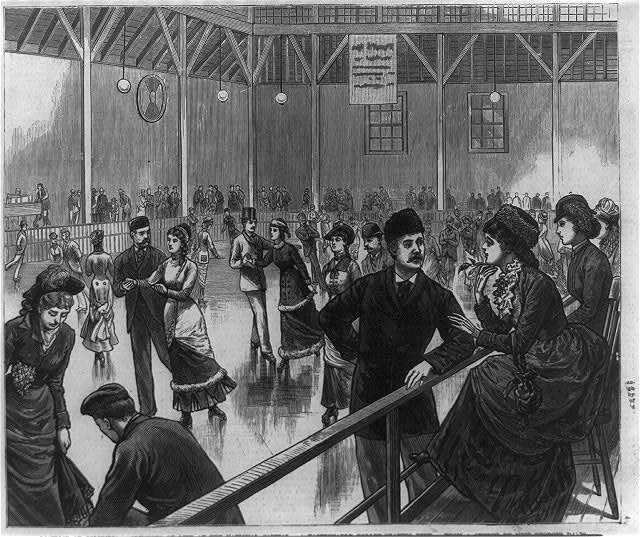Let’s Roll
For a printable version of this article, please click here.
Did you know…
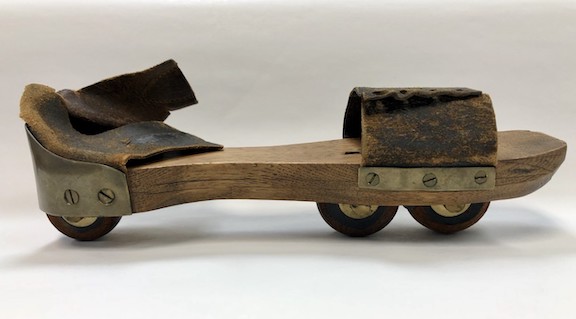
The world’s first patented roller skate, invented by M. Petibled in 1819.
If you think of roller skating starting out in the 21st century with car hops and roller discos, you’re about a century off! The earliest known use of what we would call roller skates were in London during a play in 1743, where they were used to imitate ice skating on stage. Another set of skates turns up in 1760 in a story about Belgian inventor John Joseph Merlin, who surprised party guests by attempting to skate around the room while playing a violin at the same time. Unfortunately he didn’t succeed, instead crashing into a large mirror and severely injuring himself. The problem? At that time the wheels on roller skates were placed more like today’s inline skates, except they didn’t give skaters the ability to pivot, turn, or more importantly, stop.
The invention of the “quad skate” (what we think of as a traditional roller skate with two wheels at the front of the skate and two wheels at the back), patented by James Plimpton in 1863, changed roller skating for the better. The quad skate gave a more stable base to balance on, and skaters could turn by rocking or leaning their feet from one side to the other. Plimpton opened the first roller skating rink in Newport, RI in 1866, and followed it up by building a skate factory to fuel the demand he himself created. The popularity of roller skating grew in big cities in the East, and by the early 1870s rinks were being built out West in Colorado and California. The earliest skating rink we could find in Arizona was in Prescott in 1876, operated by “Professor” F. G. Wentworth in Luke’s Hall. Wentworth opened another roller skating rink in Tucson in 1877, and a third rink in 1878 here in Phoenix (located at what is now the Fry Building at 24 North 2nd Street). Admission on opening night was 50 cents and included skate rental. Another rink opened in Phoenix Park (now Eastlake Park) with a new hardwood floor installed in 1894 that was, “As smooth and level as plate glass.” A rink opened in Yuma in 1879, and other rinks popped up in smaller towns all over the Territory, including in Globe, Holbrook, Mineral Park, St. John’s, Nogales, Bisbee, Williams, Morenci, and even in Tombstone. (Side Note – The Tombstone roller skating rink opened in December 1882, several months after Wyatt Earp left the area. But roller skating rinks were popular all over the country at that time, so we’d like to think he might have had the opportunity to skate somewhere!)
-
Roller Fashion
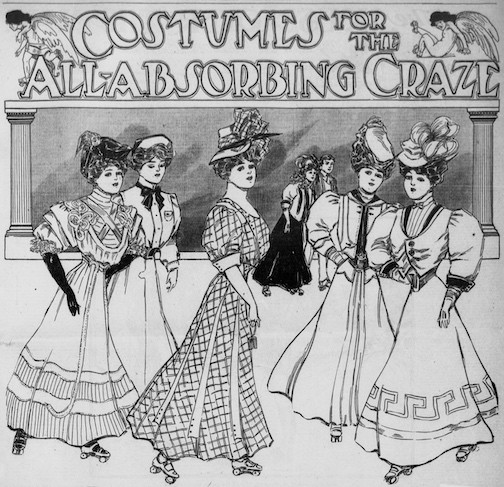 If it seems to you that Victorian and Edwardian women had a change of clothing for everything, you’re not wrong! The roller skating manuals of the day – Henley’s Manual of Roller Skating (1885) and Spaulding’s Manual of Roller Skating – suggested avoiding wearing heavy clothing like wraps or overcoats while skating, as well as long dresses, hoop skirts, and anything else that could get tangled in someone’s skates. They also advised women not to wear narrow or high heeled shoes – most skates at the time were the kind that had to be attached to a skater’s shoe, and high heels would have been very impractical to use. Neither manual had any suggestions for corsets, but luckily we found this ad for an actual roller skating corset for any of you who, like ourselves, were concerned about people wearing the proper undergarments for roller skating (ha!). Fashion plates and newspapers also showed the latest roller skating styles – as you can see, clothing trends changed in the thirty years between these two fashion plate images (left – 1880, right – 1910).
If it seems to you that Victorian and Edwardian women had a change of clothing for everything, you’re not wrong! The roller skating manuals of the day – Henley’s Manual of Roller Skating (1885) and Spaulding’s Manual of Roller Skating – suggested avoiding wearing heavy clothing like wraps or overcoats while skating, as well as long dresses, hoop skirts, and anything else that could get tangled in someone’s skates. They also advised women not to wear narrow or high heeled shoes – most skates at the time were the kind that had to be attached to a skater’s shoe, and high heels would have been very impractical to use. Neither manual had any suggestions for corsets, but luckily we found this ad for an actual roller skating corset for any of you who, like ourselves, were concerned about people wearing the proper undergarments for roller skating (ha!). Fashion plates and newspapers also showed the latest roller skating styles – as you can see, clothing trends changed in the thirty years between these two fashion plate images (left – 1880, right – 1910).
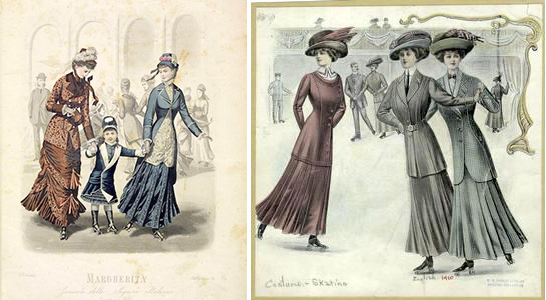
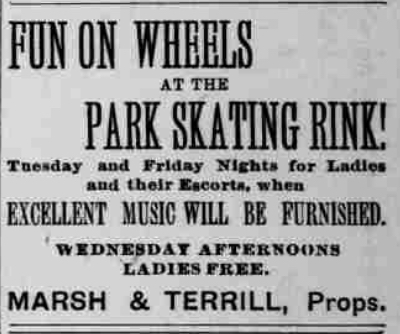
Ad for the skating rink at Phoenix Park, now Eastlake, from the December 6, 1893 Arizona Republican newspaper.
There were naturally some people who just couldn’t stand to see everyone having so much fun, and were against roller skating altogether. They said it encouraged young men and women to act loud and rambunctious, and emboldened improper conduct between the sexes without the near and watchful eye of a chaperone. A Tombstone newspaper quoted a Reverend Saunders of New York as saying roller skating was, “More deadly than the gambling hell, the theater, the saloon, or even the unwholesome literature that is often seen.” Another preacher, “Threatened to expel members of his church who (visited) the skating rink”. In 1914, the Phoenix Women’s Club protested the Eastman’s roller rink being open on Sunday, being clear they didn’t like the place any day of the week, but particularly scorned it on the Sabbath.
But for most, roller skating was a fun way to get exercise, spend time with friends, family, and their community, and to be entertained. Skating Clubs were created so like-minded people could gather for special nights at the rink – Phoenix , Tucson, Tombstone, Nogales, and Globe all had roller skating clubs that were mentioned in their local papers. Rinks also held masquerades and dances, usually held to celebrate a holiday (like Thanksgiving, Christmas, New Year’s Eve, and interestingly, St. Patrick’s Day). People would dress up in costumes for the event, and contests were held for best costumes, and best and most awkward skaters. Unfortunately for Nick De Martini of Tombstone, the only time he was mentioned in the newspaper was when he won the most awkward prize in January 1886. We hope he got a good prize. Roller rinks would also hold what they called carnivals that generally had a costume element, but also had games, races, and music from a brass or string band (string bands = orchestra ensembles with violins, cellos, etc). They would also bring in skating professionals to entertain the crowd with races, “trick” and “fancy” skating, and comedic routines. In June 1907, the Globe skating rink brought in the elegant Miss May DeMancourt as a champion fancy skater, Professor Steele as a daredevil and champion acrobatic skater who performed “The Coast of Death” down a steep ramp, and Harry Archer as trick and fancy skater who somehow roller skated down a quarter inch wire above everyone’s heads. Rinks all over the country also hosted skating marathons – Madison Square Garden (New York City) hosted a 6-day roller skating marathon in March 1885 where the winner and one other contestant died days after participating.
-
Roller Polo
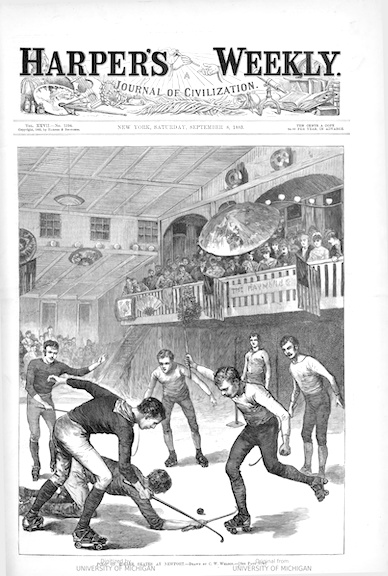 Hands up – Who thought the first hockey played in Phoenix was closer in time to when the Phoenix Coyotes moved here in 1996 than when the Rosson House was built in 1895? Yeah, us too! But a version of roller hockey, called roller polo, was played here in Phoenix in January 1914 between three local teams – the McCauley’s, Hanny’s, and Tommies. The newspaper accounts make the games sound exciting and action-packed, but unfortunately they were only played that one month.
Hands up – Who thought the first hockey played in Phoenix was closer in time to when the Phoenix Coyotes moved here in 1996 than when the Rosson House was built in 1895? Yeah, us too! But a version of roller hockey, called roller polo, was played here in Phoenix in January 1914 between three local teams – the McCauley’s, Hanny’s, and Tommies. The newspaper accounts make the games sound exciting and action-packed, but unfortunately they were only played that one month.The National League of Roller Polo was established in Dayton, OH in 1886, with games in seven cities around the US. By the time we had roller polo games here in Phoenix, there were teams playing in Massachusetts, New York, Maryland, Missouri, Kansas, Wisconsin, Illinois, Connecticut, Michigan, Indiana, and Maine. It was never hugely popular, but roller polo did have a couple players who would later become celebrities – Stan Laurel (of the Laurel and Hardy comedy duo) and Charlie Chaplin played on a roller polo team as young men in England in the early 1900s.
Roller polo was played with a rubber covered ball and sticks that were smaller than today’s hockey sticks. Judges were in place behind the goals and we hope they had the ability to move fast, because goals were just posts with no net to stop the ball. Though to be fair, the roller polo uniforms also included no protective gear, so the game was risky for everyone – probably even the spectators! You can read up on the rules of roller polo from several different American leagues online in Henley’s Official Polo Guide (1885).
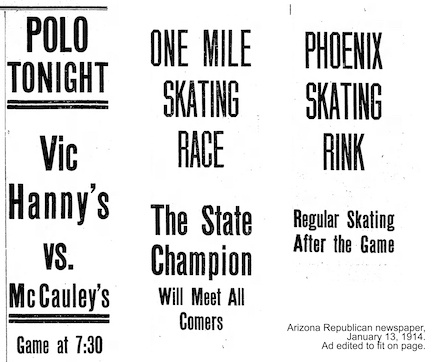
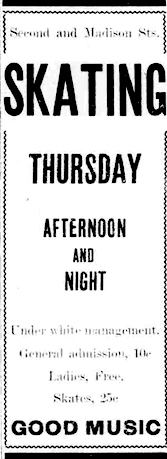
Newspaper ad, Arizona Republican, November 5, 1914.
At Rosson House, Jessie Jean Higley is said to have skated in the attic while her pet deer, Bunny, would run around the floor – what a racket they must have made! Though people would usually rent roller skates at the rink, you could find ads in many newspapers around the late 19th and early 20th centuries (particularly around Christmas) for people to go out buy a pair of roller skates of their own. You could get skates from your local hardware store or bicycle shop, and through the Sears & Roebuck catalog, too. But some people bought their own skates, not because they didn’t want to rent them from the rinks, but because they weren’t welcome in the rinks at all. In January 1885, at the height of the 1880s roller skating craze, a rink manager in Boston, MA declared he wouldn’t even let Frederick Douglass skate in his rink. In spring that same year the Arizona Silver Belt newspaper (Globe, AZ), had a brief story about, “The first and only roller skating rink exclusively for colored people” that opened in March in Philadelphia. Though the Phoenix Tribune, Arizona’s first Black owned and operated newspaper, had ads selling roller skates, neither they nor any other local newspapers at the time mention whether roller skating rinks in Phoenix were segregated to exclude African American, Latinx, and other minority groups. Since many places were – schools, hotels, restaurants, swimming pools, movie theaters, etc – it’s likely roller skating rinks were as well. Particularly rinks with ads like this one, promoting “white management”. When racism prevented Black skaters from skating at rinks, they would roller skate in safe places within their own communities, like gyms and churches. Learn about the history of roller skating in the African American community, as places for social gathering and as the first places to perform for early hip-hop and rap artists, from the award-winning HBO documentary, United Skates.
Over time, the popularity of roller skating waxed and waned. Rinks would be sold, used for something else, and often torn down to make way for something new and more lucrative. In many places, that trend followed economic ups and downs – it was more difficult to find the money to afford skates or rink admission during the economic depressions of the 1890s and the 1930s. Skating saw a boom in the post World War II years, and again in the 1970s when roller disco made it on the scene. Roller skates got another boost in 2020 when COVID hit and people were looking for a way to have fun and get exercise outside where it was safer to do so.
-
Roll Video
Before you go, watch this great 1907 short film of the roller skating craze in action, courtesy of the Library of Congress.
The image used in the heading is of a fashionable roller skating rink in Washington, DC, c1880, courtesy of the Library of Congress.
Roller mania extended all the way to Australia in the 19th century. Enjoy this video from their State Library of Victoria to learn about roller skatin’ down under!
Information for this blog article was found online at the Library of Congress Chronicling America Digital Newspaper Archive (Phoenix Herald, Phoenix Tribune, Tombstone Weekly Epitaph, Arizona Silver Belt, The Daily Tombstone, The Clifton Clarion, Mohave County Miner, Weekly Phoenix Herald, Salt River Herald, The Arizona Champion, and the Arizona Republic); the National Museum of Roller Skating – Exhibit Tour; The Lansingburgh Historical Society – Casino Roller Skating Rink, and Roller Polo; the BBC — The Victorian Craze that Sparked a Mini-Sexual Revolution; Forgotten New England – The Controversial First Days of Roller-Skating Rinks; JSTOR – “We Do Not Care Particularly about the Skating Rinks”: African American Challenges to Racial Discrimination in Places of Public Amusement in Nineteenth-Century Boston, Massachusetts; JSTOR Daily – The History Behind the Roller Skating Trend; State of Arizona Research Library – THE FRY BUILDING: A Hidden Pioneer History Part II, Woolsey & Wentworth’s; DTPHX – A Glimpse into Phoenix’s Segregated Past; Criterion Now – Roller Skating to Freedom: History Behind Black Roller Skating Culture; Triad City Beat – “United Skates” Documentary Chronicles Fight to Keep Skate Rinks Alive in Black Communities; the Saturday Evening Post – Women of the Roller Derby; the National Museum of American History – Sports: Barrier Removers; Dayton Vistas – The Gem City Polo Club and the First Roller Polo League.
Archive
-
2024
-
October (1)
-
September (1)
-
August (1)
-
July (1)
-
June (1)
-
May (1)
-
April (1)
-
March (1)
-
February (1)
-
January (1)
-
-
2023
-
December (1)
-
November (1)
-
October (1)
-
September (1)
-
August (1)
-
July (1)
-
June (1)
-
May (1)
-
April (1)
-
March (1)
-
February (1)
-
January (1)
-
-
2022
-
December (1)
-
November (1)
-
October (1)
-
September (1)
-
August (1)
-
July (1)
-
June (1)
-
May (1)
-
April (1)
-
-
2021
-
December (1)
-
November (1)
-
October (1)
-
September (1)
-
August (1)
-
July (1)
-
June (1)
-
May (1)
-
April (1)
-
March (1)
-
February (1)
-
January (1)
-
-
2020
-
December (1)
-
November (1)
-
October (1)
-
September (1)
-
August (1)
-
July (1)
-
June (1)
-
May (1)
-
April (1)
-
March (1)
-
February (1)
-
January (1)
-
-
2019
-
December (1)
-
November (1)
-
October (1)
-
September (1)
-
August (1)
-
July (1)
-
June (1)
-
May (1)
-
April (1)
-
March (1)
-
February (1)
-
January (1)
-
-
2018
-
December (1)
-
November (1)
-
October (1)
-
September (1)
-
August (1)
-
July (1)
-
May (1)
-
April (1)
-
March (1)
-
February (1)
-
January (1)
-
-
2017
-
December (1)
-
November (1)
-
October (1)
-
September (1)
-
August (1)
-
July (1)
-
June (1)
-
May (1)
-
April (1)
-
March (1)
-
February (1)
-
January (1)
-
-
2016
-
December (1)
-
-
2015
-
2014
-
July (1)
-
